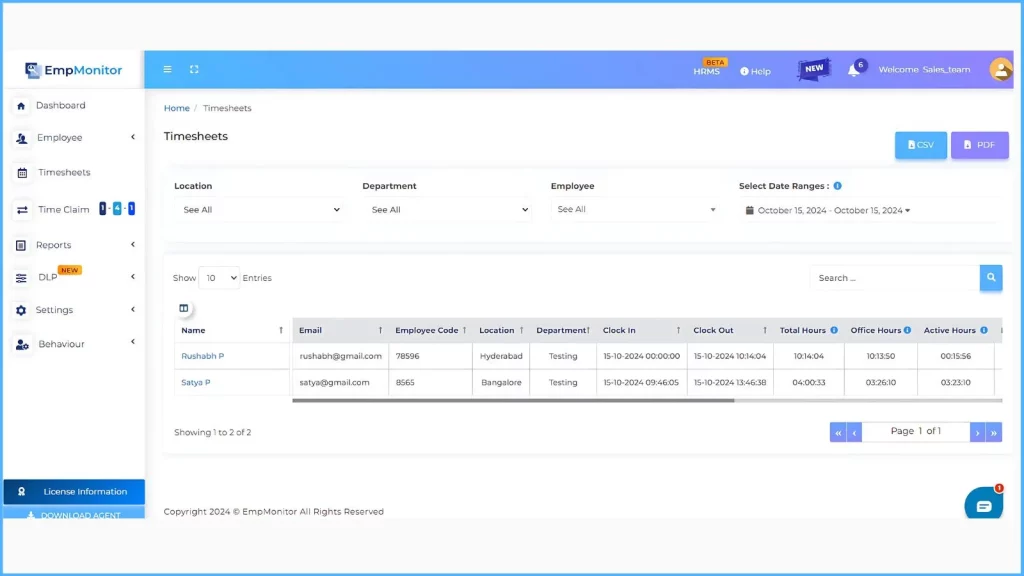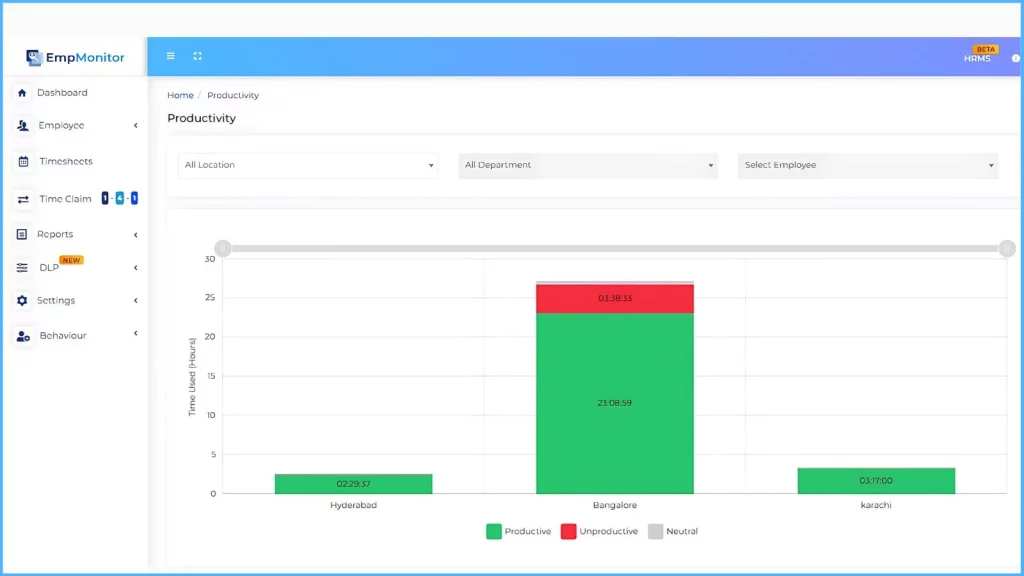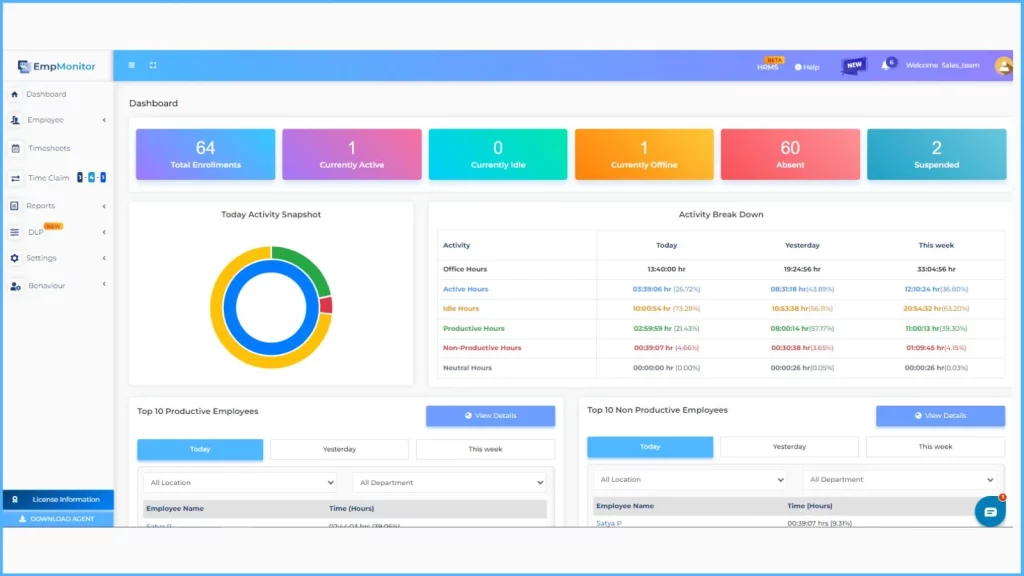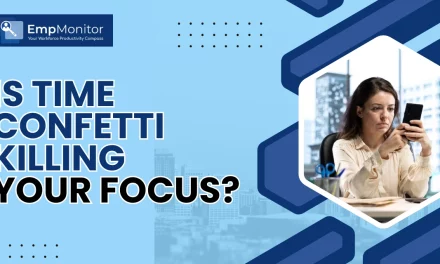Recent workplace studies reveal that a significant number of hybrid workers around 58%- have engaged in a practice known as “coffee badging.”
This term refers to the trend where employees come to the office mainly to check in, get a coffee, and then return home to continue their work remotely. This shift illustrates how employees manage their work environments, balancing the need for in-person interaction with the flexibility of remote work.
As we delve into the concept of badging, we’ll examine its implications on workplace culture, productivity, and employee satisfaction in today’s hybrid landscape.
Listen To The Podcast Now!
What Is Coffee Badging & How Does It Work?
Coffee badging describes the practice of making a brief appearance at the workplace to meet in-person requirements before heading home or to another location to finish the majority of one’s work.
The term “coffee” suggests grabbing a cup of coffee in the office while having short conversations with a manager, coworkers, or anyone nearby. Meanwhile, “badging” refers to the ID badges that employees swipe when entering the office, allowing the company’s HR and time keeping software to log their attendance efficiently.
Not all workplaces use ID badges. However, the fundamental concept remains unchanged.
If you go to the office just to attend a meeting or transfer tasks to a manager or colleague, this could simply be to follow a hybrid schedule or comply with a return-to-office or hybrid work policy. Meanwhile, you may choose to do most of your significant work at home.
In this case, you might be labeled a “coffee badger.” And you’re not alone—many others are engaging in this practice as well.
The Rise Of Coffee Badging
According to Owl Labs’ 2023 State of Hybrid Work Report, coffee badging has surfaced in the ongoing discussion regarding return-to-office (RTO) policies. This trend is widespread across multiple industries and organizations, from large tech firms to smaller businesses, reflecting a shift toward valuing meaningful engagement over simply being physically present. The report highlights that nearly 60% of employees working in office settings have reported attempting coffee badging.
Reason 1: Hesitance To Return To The Office
A significant number of employees are reluctant to return to the office, which can result in an atmosphere that isn’t always conducive to productivity. This reluctance often results in coffee badging- physically being present in the office without genuine productivity.
Solution: It’s essential to assess whether employees are more effective working remotely or if they are using their office presence as a justification to disengage. Focusing on productivity rather than merely attendance can offer clearer insights.
Reason 2: Opting For The Easy Path
Some employees may take advantage of the situation to lighten their workload, whether they are on-site or working remotely.
Solution: In hybrid work environments, it is important to assess employee performance by focusing on the quality and impact of their work rather than merely their attendance.
Reason 3: Experiencing Pressure
The obligation to be in the office at designated times can result in unproductive activities, such as commuting or socializing, instead of concentrating on work.
Solution: Implement flexible office policies if remote work is shown to be more productive. Encourage in-person collaboration during periods when it can be most beneficial.
Challenges Of Coffee Badging And Overcome With EmpMonitor Solutions
-
Challenge: Time Tracking
Coffee badging can lead to inaccurate time tracking, as employees may take advantage of flexible work hours, making it challenging to monitor their true working hours.
Solution Through EmpMonitor:
- Real-time Tracking: The EmpMonitor tool offers advanced real-time tracking features, ensuring accurate recording of work hours, including start and end times.
- Inactivity Alerts: Automated alerts inform managers when employees are inactive for prolonged periods, minimizing the risk of misuse and promoting steady productivity.
- Detailed Reports: EmpMonitor generates comprehensive reports that provide insights into daily activities, giving a transparent overview of an employee’s workday and facilitating effective performance management.
-
Challenge: Online Timesheets
Manual timesheet entries can be altered, resulting in inaccuracies in logged work hours and potentially enabling employees to conceal instances of coffee badging.
Solution Through EmpMonitor:
- Automated Entries: The EmpMonitor tool offers automated timesheets, minimizing the risk of human error or manipulation and providing a reliable record of actual work hours.
- Activity Logs: Detailed logs within EmpMonitor showcase specific tasks and activities, providing a more granular understanding of an employee’s workday beyond clock-in and clock-out times.
- Approval Workflow: EmpMonitor integrates an approval workflow for timesheet entries, ensuring accuracy and authenticity through a managerial validation process.
-
Challenge: Attendance Management with Selfie Validation
Conventional attendance methods may be vulnerable to proxy attendance or unauthorized clock-ins, compromising the integrity of attendance records.
Solution Through EmpMonitor:
- Selfie Validation: The EmpMonitor tool incorporates advanced facial recognition technology for attendance, minimizing the risk of proxy attendance and ensuring that the employees physically present are the ones marking their attendance.
- Real-time Attendance Logs: Managers receive instant updates on attendance through EmpMonitor, reducing the window for fraudulent activities and providing timely insights into employee presence.
- Geo-tagged Check-ins: EmpMonitor adds an extra layer of validation by geo-tagging check-ins, confirming that employees are not only logging attendance but also physically present at the designated location.
-
Challenge: Automatic Time Mapping
Coffee badging can result in inconsistencies when mapping actual work hours and tasks, complicating the understanding of how time is used.
Solution Through EmpMonitor:
- Task-Specific Time Mapping: EmpMonitor- employee time management software automatically maps time spent on specific tasks, providing a detailed breakdown of work activities throughout the day.
- Project-based Allocation: Employees can assign time to particular projects, improving project management and ensuring resource distribution.
- Visual Timelines: EmpMonitor visualizes daily timelines, offering a clear overview of
-
Challenge: Central Dashboard
Overseeing and managing various elements of coffee badging, including attendance, time tracking, and project progress, can become tedious without a centralized system.
Solution Through EmpMonitor:
- Unified Overview: EmpMonitor provides a centralized dashboard that offers- a comprehensive overview of key metrics, including attendance, time tracking, project progress, and team activities.
- Customizable Widgets: The central dashboard allows for customization with widgets, enabling managers to prioritize and display the information most relevant to their specific needs.
- Real-time Insights: Managers can obtain real-time insights, enabling quick decision-making and fostering a proactive approach to tackling challenges associated with coffee badging.
Hence, EmpMonitor equips businesses with essential tools for tracking productivity, enhancing security, and managing teams effectively—empowering organizations to make informed decisions and drive performance with confidence.
Reasons Behind Coffee Badging Among Employees
Here are the reasons why employees are increasingly turning to this as a strategy to navigate the complexities of work arrangements.
- Protest Against Rigid Work Policies: Employees might engage in coffee badging as a subtle form of protest against stringent in-office policies. This trend highlights a call for increased flexibility and autonomy in work arrangements.
- Voicing Discontent with Company Culture: Coffee badging can act as a discreet form of resistance against an organization’s culture that employees view as unfavorable or outdated. This method enables them to voice their dissatisfaction without confrontation.
- Adopting Hybrid Work Preferences: As organizations advocate for a return to the office, employees who appreciate the flexibility of remote work may resort to coffee badging to sustain a sense of hybrid work. This strategy allows them to minimize their office presence while still reaping the benefits of remote collaboration.
- Desire for Social Interaction Without Full Commitment: The desire for social interaction with colleagues can encourage employees to engage in coffee badging. By making short visits to the office, they meet their social needs without fully committing to an entire day in a physical workspace.
- Conveying a Message to Management: Coffee badging can be a strategic method for employees to express their dissatisfaction with management decisions, particularly those concerning in-office work policies.
What Are The Future Trends and Predictions?
The future of work is rapidly evolving, and these are the key trends and predictions shaping the workplace of tomorrow.
Expected Developments of Badging in Corporate Environments
- Sustained Presence in Hybrid Work Models
Badging will probably continue as a notable practice within hybrid work settings. This trend highlights employees’ desire for a balance between physical office attendance and the flexibility of remote work. It symbolizes a shift in workplace culture where brief appearances at the office serve to maintain connections while prioritizing personal preferences for work environments.
- Adapting to Changing Work Standards
As workplace dynamics evolve, coffee badging may prompt companies to reassess their policies and practices. Organizations might need to realign their strategies to meet the employees’ shifting expectations, ensuring that their workplace policies reflect the modern demand for flexibility and work-life balance.
Innovative Approaches and Variations
- Integration of Technology
Future advancements may incorporate new technologies, including wearable devices and sophisticated biometric systems. These innovations could enhance the badging experience, making it more secure and efficient for employees to engage in this practice.
- Creation of Flexible Hybrid Models
Companies might consider developing various flexible hybrid frameworks that facilitate coffee badging. These structures allow employees to maintain their preferred work habits while ensuring effective team collaboration and productivity.
- Impact on Broader Workplace DynamicsFocus on Employee Experience
The rise of coffee badging signifies an increasing focus on enhancing the employee experience. Organizations may prioritize flexible work options and foster social interactions, acknowledging the importance of community and connection in a hybrid work schedule and environment.
- Shifts in Organizational Culture
This trend influences a transformation in organizational culture, promoting adaptability and inclusiveness. Companies encourage finding a harmonious balance between in-person and remote work, creating an environment where both modes thrive. Tools like EmpMonitor aid in managing productivity across diverse work settings, ensuring seamless integration and performance tracking regardless of location.
As we move forward, coffee badging plays a significant role in shaping the future of work. It will not only affect corporate environments but also drive innovations aimed at improving the employee experience while redefining broader trends within the workplace.
Read More
Hybrid Work Schedule: Types, Benefits & Best Practices
How To Create A Hybrid Work Policy? (Template & Examples)
Examples of Coffee Badging
Employees use some common examples of coffee badging to extend their remote or hybrid workdays.
- The Coffee Chat Break: Employees arrange coffee meetings with their colleagues mainly for socializing rather than work discussions. After a brief in-person conversation and grabbing coffee, they head back home to continue their tasks remotely.
- The Morning Office Tradition: A group of employees regularly arrives at the office each morning, not for specific job tasks, but to engage in a collective morning coffee tradition. Afterward, they disperse to work remotely for the rest of the day.
- The Purposeful Meeting Participation: During required in-person meetings, employees attend important discussions related to their projects or duties. After fulfilling their obligations, they take advantage of the coffee break to quietly leave the office and resume working from home.
- Coffee Badge for Creative Collaboration: Teams collaborating on projects occasionally schedule in-person coffee sessions to encourage creativity and teamwork. Following their coffee meet-up, team members return to remote work while keeping the collaborative spirit alive online.
- The Hybrid Social Gathering: A company sets specific days as “social days,” encouraging employees to come into the office for informal coffee chats. This initiative seeks to connect remote and in-person work, fostering a sense of community and engagement among staff.
Wrapping Up
Coffee badging is more than just a trend; it’s a fresh approach to a hybrid workplace culture that fosters connection, creativity, and collaboration. By encouraging employees to take regular coffee breaks and engage in casual conversations, organizations can enhance team dynamics and improve overall morale.
Incorporating tools like EmpMonitor can complement the coffee badging initiative by providing insights into employee productivity and engagement. This way, organizations can track the positive impact of these breaks on team performance.
Embracing coffee badging, supported by EmpMonitor’s analytics, can lead to a more engaged workforce, innovative ideas, and a healthier work-life balance.
As workplaces continue to evolve, integrating this simple yet effective practice can create a positive ripple effect throughout your organization. So, why not give it a try? Your team might just brew up some great ideas!
Frequently Asked Questions
Q. How does coffee badging differ from traditional presenteeism?
A: Coffee badging contrasts with traditional presenteeism by focusing on symbolic attendance while prioritizing flexible, remote work rather than merely emphasizing physical presence regardless of productivity.
Q. How can employers effectively address the coffee badging trend?
A: Employers can effectively respond to the coffee-badging trend by adopting flexible work arrangements, encouraging open communication with employees, and emphasizing outcomes over physical attendance.
Q. What are some signs that coffee badging is becoming an issue in the workplace?
A: Signs may include increased employee absenteeism, lack of engagement in team activities, or employees frequently logging in but not contributing to discussions or projects.
Q: What are the benefits of coffee badging?
A: Coffee badging promotes a more approachable work culture by encouraging open discussions in a relaxed setting. It can improve relationships, spark innovation, facilitate mentorship, and build team cohesion.
Q: How can one initiate a coffee badging session?
A: Simply reach out to a colleague, manager, or team member and suggest grabbing a coffee to discuss a particular topic or connect casually. It can be in-person at a café, in a break room, or even virtually with a coffee in hand.














